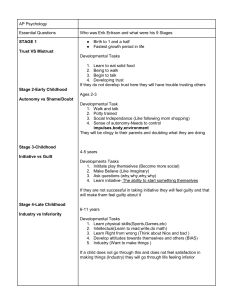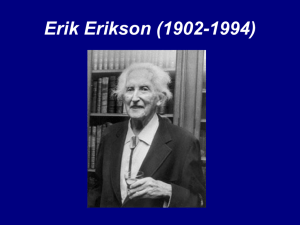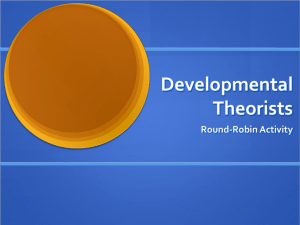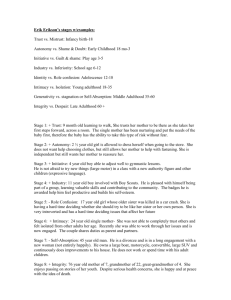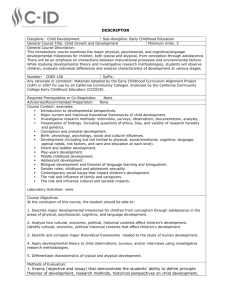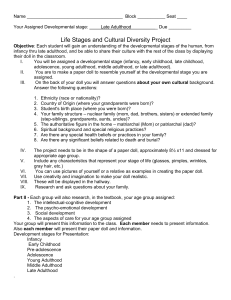File
advertisement
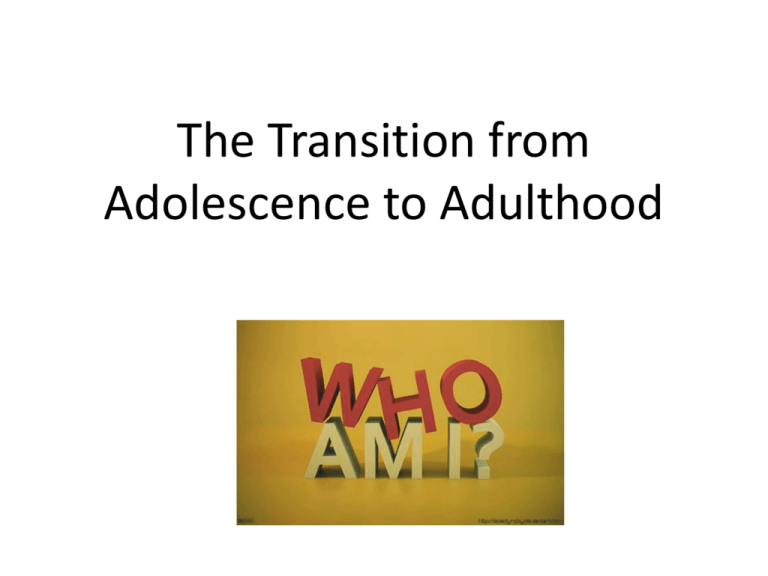
The Transition from Adolescence to Adulthood • How do we develop our identity or sense of self? What is Identity? • An individual's self definition that focuses on enduring characteristics of the self. • Is an established identity, the individual is able to explain the origins of these self-defined characteristic and the influences behind those origins • Complete identity includes a clarification of one’s morals, ethics, and standards, as well as a commitment to a future occupation ERIK ERIKSON’S Psycho(emotional)social(circumstances )Identities Stages of Development Eight Stages of Development • Each stage is determined by a specific conflict (pair of opposing impulses and behaviours) • A resolution or the inability to resolve these conflicts effects our personalities and identities • Four childhood stages and 3 adulthood stages bridged together one stage in adolescence • Basic needs and what society provides Eight Stages Stage 1- Basic Trust vs. Mistrust Stage 2- Autonomy vs. Shame/Doubt Stage 3- Initiative vs. Guilt Stage 4- Industry vs. Inferiority Stage 5- Identity vs. Role Confusion Stage 6- Intimacy vs. Isolation Stage 7- Generativity vs. Stagnation Stage8- Ego integrity vs. Despair I. Stage 1- Infancy A. Birth to 1 ½ years B. Fastest growth period in life C. Developmental Tasks 1. learn to eat solid food 2. begin to walk 3. begin to talk 4. developing trust D. Trust vs. Mistrust – – – Hope and optimism A loving trusting relationship with the mother/caregiver through feeding, teething, and comforting Failure to resolve this conflict- sensory distortion and withdrawal II. Stage 2 - Early Childhood A. B. Ages 2-3 Developmental tasks 1. walk and talk more 2. potty trained 3. social independence develops 4. Sense of autonomyneed to control impulses, body, environment. C. Autonomy vs. Shame/Doubt • Self control and will Autonomy- ability to control their bodies and environment Shame and doubt develop when the child is shamed or forced to be dependent in areas in which she/he is capable of independence III. Stage 3 - Childhood A. B. 4-5 years Developmental tasks 1. Initiate play with other kids 2. Make-believe 3. Ask questions 4. Learn initiative- the ability to start something on their own. C. Initiative vs. Guilt • • • • Purpose and direction Children are active and have powerful imagination Initiative- independent decision making about planning and doing various activities May develop guilt for their desire of independence IV. Stage 4 – Late Childhood A. B. 6 to 11 years Developmental Tasks 1. learn physical skills for sports, games, etc. 2. intellectually- learn to read, write, do math 3. learn right from wrong 4. develop attitudes towards themselves and others. 5. develop sense of industry- make thingscookies, models, etc. C. Industry vs. Inferiority • Competence Industry: motivation to keep learning and practicingwant to be productive instead of just wanting to play When not encouraged to work and learn skills feel inferior and unmotivated Conflict between what they should do and should not do Completing an Education: The Development of Education • Education is a fairly recent development in human society • Prior to the 15th century, knowledge was spread through story-telling and youth learned skills from their parents – Girls became mothers and boys performed the labour or craft of their fathers – In the Middle Ages, wealthy boys were sent to “Latin schools”, but very little education actually took place because the boys were undisciplined V. Stage 5 – Puberty/Adolescence A. B. C. D. E. F. Ages 9 – 13 & 14-17 Beginning of adolescence Become capable of reproducing Secondary sex characteristics begin to develop Second fastest period of growth Hormones develop- estrogen & progesterone-girls & testosterone-boys G. Developmental Tasks 1. Form mature relationships 2. Achieve a masculine or feminine social role 3. Accept one’s physique and use one’s body effectively 4. Achieve emotional independence from parents and other adults 5. Prepare for marriage and family life 6. Prepare for career 7. Acquire personal standards 8. Develop social intelligence-aware of human needs-helping others 9. Develop conceptual and problem-solving skills • Identity is characterized by integration of personal values with those of society, a clear sense of self in multiple roles, and by making choices of the future. • A healthy Identity- one’s organization of individual drives, abilities, beliefs, and experience into a consistent image of self • Role Confusion- Failure to establish an individual identity separate from the family and having no peer relationships and plans for an occupation https://www.youtube.com/watch?v=_t0y-gCySN0 • James Marcia’s Identity Formations As you watch the video take notes on; 1. Identity diffusion 2. Identity Moratorium 3. Identity Foreclosure 4. Identity Achievement VI. Stage 6- Young Adulthood A. Generally age 20 to early 30’s- can start as young as 17. B. Financially independent from parents C. Can deal with everyday life trials with maturity D. At peak of physical abilities- strength, quickness, alertness E. Crucial life decisions made- marriage, career, children F. Intimacy vs. Isolation • Form identities and start looking for close reciprocal relationships • Intimacy develops when the person creates mature relationships with a partner • Isolation- inability to create intimate relationships • Am I loved? Am I wanted? Shale I share my life with someone or live alone? VII. Stage 7- Middle Adulthood A. B. C. D. E. 35-65 years Start thinking in terms of what to do with the rest of their lives. Feeling that time is running out Start to face death of parents Mid-life crisis common- divorce, career change, remarriage 1. some have not accepted middle age- can lead to problems adjusting 2. Their children may be going through adolescence, during this time which can add to conflict. - Care- primary developmental task is one of contributing to society and helping to guide future generations Generativity- Concern of establishing and guiding the next generation- promote well being of others Stagnation- a dissatisfaction with the relative lack of productivity VIII. Stage 8- Late Adulthood A. B. C. D. E. F. 65 and older Retirement common Senior citizen does not equate to old anymore. Longer life expectancy- 85 and older common. Better health practices than in the past. Measures of Age 1. Chronological- How old you actually are 2. Biological- how well your body is holding up influenced by diet, exercise, lifestyle, heredity 3. Social- a person’s lifestyle G. Grandchildren become important H. Must face death - Wisdom- Integrity vs. Despair - Integrity- when a person developed wisdom over a lifetime and can look back and see a life of meaning - Despair- A sense of not accomplishing one’s goals or values and it is too late to do anything about it. Reading: Erikson Complete reading- chart and personal examples For each stage: - Discuss one example- ideally from your lives- that illustrates a particular stage- specific crisis - Describe a positive and negative outcome for your example. - For example- stage 4- school age- is when children begin school and learn new skills. If this stage is met successfully, a child will develop a sense of competence. He or she is more likely to feel confident about learning new subjects in school, talking in class, and taking in new challenges. If not, he or she will develop a sense of inferiority, may be reluctant to ask questions, and could fall behind, feeling discouraged - Class discussion on your examples Developmental Theories: • Complete reading/chart • Will break into groups and present your findings • Total Marks: / 10 Communication
